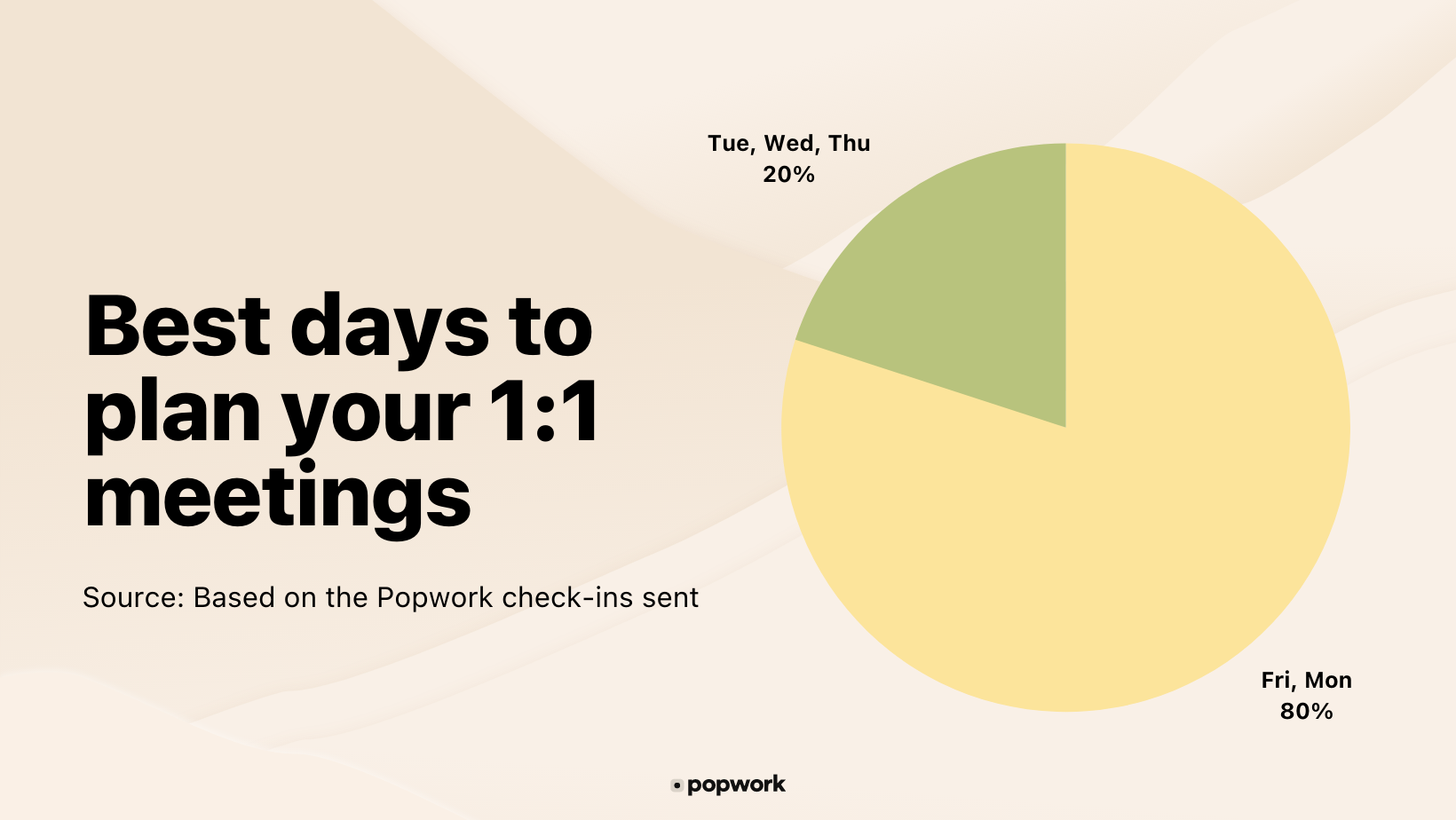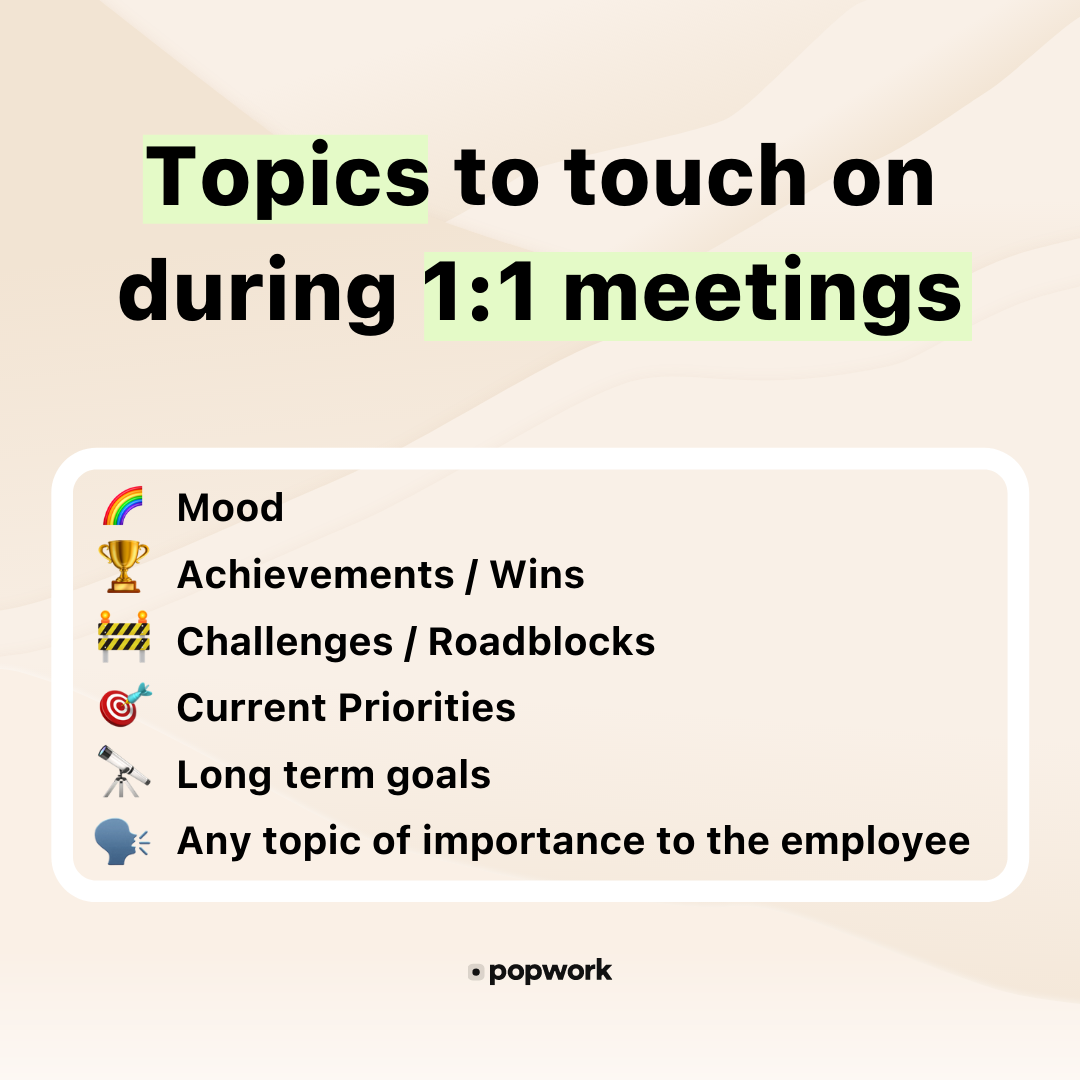As a manager, you need to meet in-person or via video-conference with your team members on a regular basis. Some organisations have clear rules on cadence and format, others have recommendations while some give total freedom to managers.
At Popwork, we believe in the importance of management rituals and think companies with weekly or bi-weekly one-to-one meetings (1:1s) are best set up for success.
Set up your one-to-one ritual 🗿
The first step in creating an effective ritual is to set up a recurring format:
- Choose a cadence - every week or two - and stick to it
- Choose a consistent time - 30, 45 or 60 minutes
- Hold the 1:1 away from the desk - in a meeting room or head outside for a walk
Determine the agenda of the meeting 🗓️
Preparing a relevant agenda can sometimes be a challenge. We recommend following a simple structure such as the following:
- Mood and conversation starters : How was your week ? How are things ? What have you been up to ? How can I help you ?
- Achievements and reasons to be proud
- Objectives & priorities update
- Challenges and roadblocks
- Next steps
Using a tool such as Popwork which includes a check-in feature makes preparation for 1-to-1 meetings easy and intuitive.
Meet for the one-to-one 🧑🤝🧑
One-to-one meetings are an important moment for team members and managers as it is their opportunity to step back and discuss important matters together. Therefore, we encourage you to:
- Be on time and give the meeting your full attention
- Stick to the agenda and to the defined timing - as much as possible
- Ask for feedback
- Coach when necessary
- Review action items and topics for discussion for the next 1:1
- Ask “What else?” - you’ll be surprised what you can learn with this last open question
Whether you use a tool such as Popwork or not, your attitude will always be the most important aspect of every 1:1. If your team members feel that these meetings are key for you and a great tool to remove roadblocks, receive feedback and help get things done, these 1:1 meetings will transform the way your team works.
Determine next steps and follow up ✍️
One essential piece of 1:1 meetings is often overlooked : next steps and follow-up. If there are no next steps as an outcome of the meeting and if these next steps are not followed up on then the 1:1 meeting was nothing more than a light conversation.
When wrapping up the 1:1, don’t forget to confirm actions, topics to discuss further and agreements. A good way to do so is to create a shared note with actions owned either by the reportee or the manager. As a manager, don’t hesitate to own action items as well to help remove hurdles for your team members
Finally, during your next one-to-one, start by taking a minute or two to review previous action items or topics for discussion to make sure everything has been done or covered.
In summary, the 10 commandments of 1:1 meetings 📜:
1. What’s the best day to set your 1:1 meetings?
Monday: it’s always very efficient to start the week with the right priorities
Tuesday, Wednesday, Thursday : less relevant because it’s right in the middle of the week
Friday: it’s usually a good time to step back at then end of the week and prepare for the next one
At Popwork, we observe that more than 80% of our users schedule their 1:1 points on Friday or Monday.

2. How often?
The most common frequency among teams is weekly. Having a weekly update is generally well suited to most managers and team members. It gives enough time to have new things to discuss and not too distant so that you don't lose track of things or slow down the follow-up. However, if you manage a more senior team with very autonomous team members, bi-weekly updates may be sufficient.
3. What time?
Some people prefer to do their 1:1 at the end of the day to have time to make progress on their topics before, others prefer to meet in the morning and then have time to focus on the next steps that come out of the discussion. We recommend that managers and team members discuss this directly to take into account their preferences. There is no real rule here; however, some teams prefer to have their 1:1 meetings in the morning - when they are still fresh and full of energy!
4. Where ?
You need to be in good conditions, which means a quiet environment where you will not be disturbed; otherwise it will be difficult to focus and have a good discussion. At the office, avoid open spaces (where other people can hear your discussion, which can make your team member uncomfortable) and favor your office or a meeting room. Why not even have your 1:1 meeting in the cafeteria or try a walking meeting? When working remotely, in a video conference, make sure to close the other tabs on your computer so that you can fully focus on the discussion.
5. What duration for a 1:1 meeting?
Our recommendation and the average length of time among teams is around 30 minutes. This will give you time to have a real discussion, to deep dive into certain topics without spending too much time. In 15 minutes, you usually just skim over the topics and the discussion remains too superficial. On the other hand, holding one-hour meetings is probably too much for a weekly meeting and there is a risk of ending up micromanaging your team.

6. How to prepare for the discussion?
A poorly prepared weekly 1:1 meeting will always result in an unstructured, inefficient and frustrating discussion for both the manager and the employee. A total waste of time! This is why we believe in the importance of the check-in, i.e. a few questions asked before the meeting to help team members take a step back from their work and give the manager enough information. 5 questions are generally enough to cover all the important points:
- How was your week?
- What have you achieved since our last week?
- What are your priorities for the week?
- What challenges or roadblocks are you facing?
- What else would you like to add or discuss?
Solutions like Popwork can help you set up this workflow each week and help you surface all the important topics.
7. How to run the discussion?
The topics may vary depending on the current events or the needs of each employee. Nevertheless, there are certain topics that must be addressed at each weekly 1:1 meeting and they must be addressed in the right order:
- Start the discussion by talking about mood: this allows you to take the pulse and spot any weak signals. It may seem obvious, but you always learn things when you take the time to ask "how are you doing?"
- Follow up with the recent achievements: this way you value the work that has been done and get the discussion going in a positive direction. It gives recognition and builds confidence.
- Then, align on the priorities for the week: you can make sure that you are aligned and that the right topics are prioritized. This way you avoid any misalignment or misunderstanding.
- Close the discussion by addressing any roadblocks and other important issues. By doing so, there's no important topic that can be forgotten or overlooked. Your team members will have everything they need to make good progress until your next catch up.

8. Which attitude to adopt?
Beyond the topics covered during the conversation, the attitude of the manager and the team members play a very important role in the good dynamic of a one-to-one meeting. Don't avoid difficult subjects, but always do so with a positive attitude. Try to position yourself as a coach who is available and gives advice and not just as a boss who controls the work done!
9. Which feedback ?
The 1:1 weekly meeting is the basics of good management. Use this bilateral format to share feedback. This is how you can build a good relationship based on trust, and it is also what will allow your team to improve. When sharing feedback, remember to be specific and constructive in your messages and then take the time to listen.
10. How to follow up?
A discussion without clear next steps or action points is like the discussion never happened. Therefore, always make sure you come out of your 1:1 meetings with clear and concrete results. This will clarify what needs to be done and, at the next 1:1 meeting, you will be able to easily measure the progress made on each topic.
Wrap-up: One-to-one meetings are a very powerful management ritual when done right. With the right preparation, the right attitude and a thorough follow up, it will become one of the most useful tools for a manager.
To find out how to make 1-to-1 meetings easy and efficient for your team with Popwork, click here.

